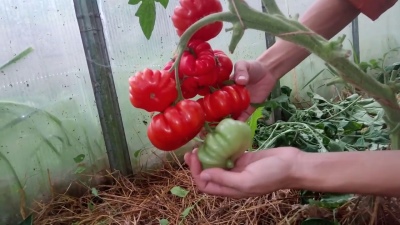
- Name synonyms: F1 female share
- Category: hybrid
- Growth type: indeterminate
- Appointment: universal
- Ripening period: early
- Ripening time, days: 91-109
- Growing conditions: for open ground, for closed ground
- Bush size: medium-sized
- Bush height, cm: up to 180
- Ripe fruit color: bright red
A hybrid called Women's Share was developed by specialists from an agricultural firm in the Chelyabinsk region. He is currently still under observation for more detailed study. Before growing a variety, you must definitely familiarize yourself with the specifics of cultivating this fruit crop.
Description of the variety
Tomato is cultivated in indoor and outdoor conditions. Growth type is indeterminate. The fruits have a universal purpose. Medium-sized bushes grow on average up to 180 centimeters. Under certain conditions, they stretch up to two meters. To restrict growth, the top of the central stem must be pinned. The green mass is lush and dense. With proper cultivation, the roots become spreading and shallow. Bushes are strong, in need of shaping and garter. Otherwise, the shoots will tilt towards the ground under the weight of the crop.
The first fruit cluster is formed after 5-6 leaves, and the rest alternate every 4 leaves. Typically, about 7 to 9 brushes are formed on each plant. Up to 10 flowers are formed on one brush.
The main qualities of the fruit
Ripe tomatoes take on a rich red hue. Sizes are marked as medium or large. The weight varies from 180 to 200 grams. Fruits are strongly flattened with expressive ribbing. The shape of the tomatoes is very unusual, they seem to consist of several separate lobes. This feature markedly distinguishes them from other varieties. In diameter, vegetables grow up to 6-8 centimeters. They are covered with a strong but thin skin that does not crack. In the region of the stalk, a greenish spot is observed, especially in unripe tomatoes.
There are no voids inside, and the pulp is fleshy and juicy. A small seed chamber is hidden in each lobule. The seeds are small and in small quantities.
Taste characteristics
Gardeners note the high gastronomic quality of the crop. Ripe tomatoes have a sweet, full-bodied and very pleasant taste. The sourness is very light and subtle, it only sets off the special taste of vegetables. Ripe tomatoes are often enjoyed fresh during the fruiting season. And also from them you can prepare the following blanks: canned salads, sauces, pastas and dressings.
The crop can be stored for a long time without loss of marketability. Some gardeners harvest in summer and leave to ripen until fall. And also tomatoes are not afraid of long transportation.
Ripening and fruiting
The female share belongs to the early varieties, and the ripening period is from 91 to 109 days.
Yield
When growing vegetables in greenhouses, from one bush is harvested from 3.8 to 4.5 kilograms, and in open ground - up to 3 kilograms. Such indicators indicate good yields.
The timing of planting seedlings and planting in the ground
In the period from early March to April, seeds are sown for seedlings. Ready seedlings are transferred to the beds in June, and work in greenhouses is carried out earlier, from April to May. The seed is not harvested on its own, since it will not retain the properties of hybrid tomatoes. The products presented in stores have already been treated against fungus and other infections.For germination, choose a nutritious soil.
As soon as the seedlings germinate enough, a pick is carried out. 10 days after the transfer of seedlings in separate containers, the plants are fertilized with complex compositions for tomatoes. Approximately 2 weeks before transferring the bushes to open ground, they are hardened. Otherwise, they may not take root in a new place.
The process of planting young plants.
The selected area must be prepared in advance. The land is cleared of plants, debris and dug up.
Wells are watered abundantly with settled water.
Add one tablespoon of ammonium nitrate to each hole.
Seedlings, together with an earthen clod, are immersed in the holes, and the soil around is compacted.
A layer of mulch is laid around the stems.

Growing tomato seedlings is an extremely important process, because it largely depends on whether the gardener can harvest at all. All aspects must be taken into account, from seedbed preparation to planting in the ground.
Landing scheme
The recommended landing pattern is 30x50 centimeters.

Growing and care
If the bushes are grown indoors, watering is carried out 2 times a week. The greenhouse must be regularly ventilated so as not to provoke moisture stagnation. The humidity level should not be higher than 65%. Vegetable crops need fertilizers. Tomatoes are fed 2 times a month using mineral complex compounds. Organic matter is introduced less frequently.
As it grows, shoots appear in the axils of the plants, which must be removed regularly. Get rid of stepchildren about once a week. For hybrid tomatoes, it is recommended to leave a strong bottom stepchild, which will grow into a second full-fledged trunk. The work to remove lateral shoots is performed no earlier than 2 weeks after plant transplantation.
To obtain a high-quality harvest, it is recommended to form the plant into one or two stems. So that the plants do not waste energy on the formation of green mass, the lower leaves are removed. To achieve a large fruit size, no more than 3 ovaries are left on one brush.




A plant needs different micronutrients at each stage of growth. All fertilizers can be divided into two groups: mineral and organic. Folk remedies are often used: iodine, yeast, bird droppings, eggshells.
It is important to observe the rate and period of feeding. This also applies to folk remedies and organic fertilizers.



























































































